Hadleigh Castle Brief
What is a Brief
A creative brief is a short, written document used by project managers and creative professionals to guide the development of creative materials (e.g. drama, film, visual design, narrative copy, advertising, websites, slogans) to be used in communication campaigns.
A media brief can be referred to as a checklist for the media planners to help them prepare media plan for a client organization. Media planning is not an isolated function but an integral part of an overall campaign planning. Hence a media planner needs to have a thorough knowledge of all the variables.
A good media brief should ideally include the following:
-Marketing information checklist (marketing objectives and proposed strategies, product characteristics, distribution channels, brand category and expenditure level).
-The objectives (This must clearly indicate whether the objective is to introduce a new product, increase awareness about the existing brand, reinforce the current position or improve or enhance the company’s reputation).
-Product category information (This helps in assessing the strengths and weaknesses of the brand and also helps in setting achievable targets).
-Geography/location (The media brief helps the planner in knowing his media markets).
-Seasonality/timing (Information regarding seasonality of the product is an important consideration for the media planner).
-Target audience (A profile of those who buy the existing category as also those who buy competitive brands is a very important consideration for the media planner)
Brief Structure
There are many ways to structure a design/idea brief. Here’s one recommended structure:
-The goal. Identify the core nugget that explains what you’re pitch is trying to achieve.
-The idea. This is a version of your 5 second pitch.
-The problem. This is a modified version of a pitch set-up: as it provides a framework for the idea.
-The audience. Who will this idea appeal to? What is the profile of the potential customer? What is the profile of the non-customer?
-The approach. How does the idea work? Explain, at a high level, the outline for how the idea will be implemented.
-Challenges & Unknowns. What are the big open issues that need to be resolved, or are questions a reasonable person would ask?
Structures of different Briefs
Contractual Brief (example A)
A Contractual Brief is a contract created by the Client who will give the brief to a Production House or Media Company. This type of brief cannot be negotiated like a Negotiated Brief as the client sets all the guidelines for the Production. A Contractual brief explains what the rules are between both the client and the worker. It tells you about what the client wants from his job helping the worker understand what they want.
A Contractual Brief has its advantages as the Media Company will know and understand what the product is and how it should be created. However this does mean that the Production Company will have no input on how the production should go, and if any improvements can be made.
Negotiated Brief (Example B)
A Negotiated Brief is discussed between the Production Company and the Client. It will usually be discussed at a Client Meeting where the ideas, principles and the how the product will be produced are discussed. When negotiating through the contract, they don’t stop the discussion until they have an agreement altogether. This has the advantage over a Contractual Brief where the Production Company can have a form of input into the brief meaning that any proposals that the client makes that do not seem appropriate or suitable for the Production.
When comparing a Contractual Brief to a Negotiated Brief it is clear that depending on the product, both have their advantages. For a large-scale production a Contractual Brief is best suited as it will be more detailed and directed towards the outcome of the final product. Whereas a negotiated brief is best suited for a smaller production where the client may need some pointers and improvements, which will make the overall product a higher quality.
Formal/Informal Briefs
When writing any style of brief there is a significant difference between a Formal Brief to an Informal Brief. A Formal Brief is one that would be discussed in great detail between the Client and the Production Company, and would include Meeting Minutes and Sign Off sheets throughout the process. Whereas an Informal Brief is one that would be discussed in little detail, mainly with the client handing a Brief to the company and having a quick meeting. The Informal Brief can mainly be used when the project is a small idea or is to be used by a small-scale client, whereas a Formal Brief will be used in a large-scale production for a large client. When comparing a Formal to an Informal Brief, it becomes clear that a Formal Brief is a more effective style as it will include significant amounts of data compared to an Informal Brief, and this means that the production will be of a higher quality.
A formal brief is very easy to read and helps the client to understand the different aspects of the contract. It’s similar to an income brief where it’s nice and relaxed which means the contract isn’t complicated to read, but instead quite easy which means they can get the job done quickly and sufficiently.
An informal brief has no strings attached, but the issue with having an informal brief is that it’s just a meeting, which means all the details are verbally told and not on a written document.
Commission Brief
A Commission Brief is a standard brief with an extra increment, of which allows the Client of the Product to apply to have the money Refunded after the completion of the Product. This is a form of Commission, however, if the client does get a refund, the product can then no longer be used for the purposes desired, meaning that a new product or service will have to be made. When somebody commissions a brief they hire a separate independent media company to create a product for them coming, formulating their own research, proposals and ideas for the product which is then overseen by the commissioner.
This works well for the independent company because they are getting paid for doing their job as well as the chance to have a share in the profits made by the company meaning they are ending up with a healthy profit. The issue is that the company doesn’t get such an active role in the decision making for the product and so they could end up with something very different to what they expected.
Tender Brief
A Tender Brief is where a Client will produce a Brief and distribute it to multiple Production Companies. This will allow the Production Company to make an offer to the client and also explain any ideas that they may have. This will allow the Client to choose the best Production Company for their needs in order to have the product created. This very similar to somebody advertising a job advert, where by the client publishes an advert showing that they need a media product to be made. Advantages to using this type of brief is that the client has access to a number of different ideas that maybe were not initially thought of.
Cooperative Brief
A Cooperative Brief is where a Client will hire multiple companies, or where a Company approaches another company in order to help with a single production. This is mainly used on large-scale productions such as Films or Advertisement and Animations. It is a great method of collating multiple ideas and also helps to increase workflow, as it will allow more people to be working on the same project, allowing for a sooner completion time and also allow for a higher standard of work.
Competition Brief (Example C)
A Competition Brief is when an Idea is created, and a brief is distributed to the public in order to get the Public to make the Product in line with the brief. This is in order to get many free products made at the cost of the competitions prize, which is most typically a lump sum of money, or a contract to the Brief Creator in which will mean that the creator of the product will then on make the rest of the Products that the Client will require. An advantage for the company is that most of the time these types are projects become available through competitions or advertisments and the winning idea is given a prize or paid in cash which can work out cheaper for the company then any other way. As well as the fact that the company can take on other work on the side meaning they are making more money as the business is expanding. However, it means that after all that work put into each production company only one will get chosen and paid meaning the others have make their projects for nothing without prizes or being paid.
A.  |
C.  |
B.  |
|
Negotiating the brief
Working to a brief is all about client satisfaction, if they view is positively you’ve succeeded.
First, the client will have a issue and the client or a brief agency will write a brief to resolve that problem and then, give it to a company to produce it.
Consultation with the Client
Depending on the type of Brief that the Client and Production Company are working with, there will always be a Consultation with the Client. This will be either a formal or informal meeting between the client and the production company. The meeting will be used for discussing the brief and the ideas within the brief.
Degree of Discretion in Interpreting the Brief
Like negotiating a brief, there is also a degree of discretion that occurs when dealing with a client. For example, when you receive a brief you have to interpret the ideas and think about them in a technological sense. This means thinking of how you would create the production, how you would distribute the production and also how the client wants it to look. This is where a meeting or consultation is used in order to discuss the ideas between the client and production company.
Constraints (Legal, Ethical and Regulatory)
When dealing with any brief, or making any form of media product that is going to be seen by the public, it is crucial that the Legal, Ethical and Regulatory constraints are deeply thought through. This means making sure that the ideas and themes that are within the product are not in any way racist, homophobic or cause any emotional or physical harm to a group of people. This is also the case where Legal constraints have to be thought of, as there are many government created laws and regulations that have to be abided by. This can be the Data Protection Act, Advertising Standards Authority, Ofcom, EU Competition Commission and many more. It is vital that any production has a detailed report of how the product will not affect any of the Laws and Regulatory Bodies. When comparing the different Constraints that can affect any Media Product, it is clear that Legal Constraints are the hardest to avoid, as it requires a true understanding of all the laws and regulatory bodies that can have an effect on the product being made. Whereas the Ethical Constraints can be worked upon in order to be avoided, such as having different ethnic groups working on the one product in order to make sure that no beliefs or themes go against the different ethnic groups.
Amendments to Proposed Final Product
During the Production Process there can be many different stages at which ideas can be changed or developed. This is why all production companies use Sign Off Sheets. These are a form of security, which states that when something has been done, the client cannot change it. This makes the production process easier and more effective for the Production Company, as if the Client were to say that they wanted to change the product halfway through Production, then the company would have to do so, but with a Sign Off sheet it makes it impossible for this occurrence to happen.
Amendments to Budget
This will be either when new costs have arisen or prices have changed, and the new costs will have to be discussed with the client to ensure that they are happy to pay for the extra amounts.
Amendments to Conditions
Like making an amendment to the Final Product, changing the conditions of the product will have an affect on the final product.
Negotiating the Fees
When it comes to the first consultation with the client, it is vital that all of the costs that will be involved in making the product are discussed to a high standard. This is firstly by the client, by them running through all of the costs that they will pay for, and then the Production Company will have a detailed list of all the costs that will be involved, in order to settle a final price for the product.
Opportunities
-Opportunities for Self Development
When working with a Brief it allows the Producer and the Client to develop new skills. These can be from learning new communication techniques, development skills in producing the product and also increasing the range of ideas that one can have about different products.
-MultiSkilling Opportunities
When working for any Production Company or as a Sole Trader there will always be more than one project on the go. This means handling and following multiple briefs at any one time, and therefore helps to improve any multi-tasking skills that you may have.
This can be developed mainly by working on two different briefs, such as an Animation Brief and a Movie Brief, and also working with Contractual Briefs and also Negotiated Briefs at the same time can also be an advantage to the producer, as it means that they can work on one project effectively. The producer will also be able to switch between their working day on the different projects effectively, and this skill is crucial when working within any media industry company.
-Contributions to a Project Brief
When working on any brief, the creators of the product will normally be able to have their own input into the project idea. However this is not possible when working with a Contractual Brief. However, being able to have the input that the producer has can allow for the idea to be further developed, and also discussing different methods of filming and planning can rectify any flaws within the idea. This can lead to bigger and higher quality products to be made, which will not only be good for the producer, but also it will please the clients, making them more likely to recommend the company to other potential clients.
Skills required to fulfill a Brief
For any person who will be working with a Brief, whether it is a Negotiated Brief or Contractual Brief, it is crucial that the person dealing with the product and clients has the skills that will enable them to work effectively and appropriately towards the brief.
-Reading a Brief
When the Company or Producer receives a new Brief, it is crucial that the context of the Brief is fully understood. Firstly the Idea has to be understood, as without an idea the Product cannot be made. When starting any project it is important to read through the brief that you have been set because it will express what the client wants, and so with this information you are more likely to create something that is appropriate for its purpose.
Research

Hadleigh Castle is a ruined fortification in the English county of Essex, overlooking the Thames Estuary from south of the town of Hadleigh.
Built after 1215, during the reign of Henry III, by Hubert de Burgh, the castle was surrounded by parkland and had an important economic and defensive role. The castle was significantly expanded and remodelled by Edward III, who turned it into a grander property, designed to defend against a potential French attack, as well as to provide the King with a convenient private residence close to London.
Built on a geologically unstable hill of London clay, the castle has often been subject to subsidence; this, combined with the sale of its stonework in the 16th century, has led to it now being ruined. The remains are now preserved by English Heritage and protected under UK law as a Grade I listed building and scheduled monument.
History
In 1215 Hubert de Burgh was gifted the manor of Hadleigh by King John. Hubert at the height of his power transformed it into what is now Hadleigh Castle.
By 1239 he was forced to renounce his land to the royals, this led to its disuse for nearly 100 years till Edward II used the castle as his royal residence and was further built up to complete Hadleigh Castle.
Edward III was the first king to see the strategic importance of Hadleigh Castle – it was ideally situated as a base for defending the Thames estuary against French raids during the Hundred Years War.
Edward’s claim to the French throne had led to war with France. The need for a more systematic defence of the Thames estuary led the king to refurbish and extend Hadleigh Castle and to build Queenborough Castle on the opposite Kent shore.
Hadleigh became a favourite retreat for the ageing king. There are excavated foundations of the most important part of the castle – the great hall. It had a serving room at the end and beyond it a private withdrawing room, or solar.
Today
The Salvation Army gave the castle to the Ministry of Works in 1948, and it is now owned by English Heritage, classed as a scheduled monument and a Grade I listed building.
The castle is still surrounded by the 19th-century Salvation Army farm, and beyond that by Hadleigh Country Park, owned and managed by Essex County Council and a Site of Special Scientific Interest with special regard for invertebrates. In 2008, Hadleigh Farm, close to the castle, was announced as the venue for the mountain biking competition in the 2012 Summer Olympic Games.
What is left of the Castle

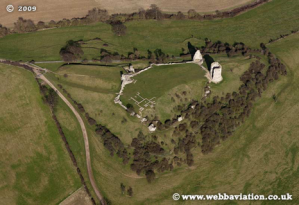
Surrounding Landscape

Interactive Signs (used for narration)
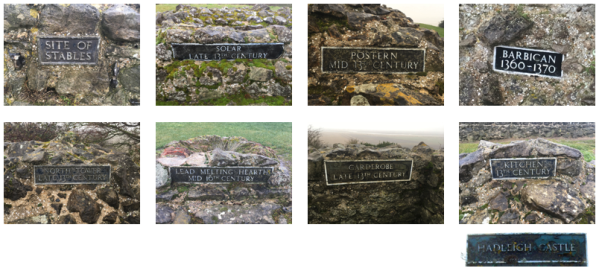
Example Textures

What we think the castle looked like

Example Buildings of the year 1300

Example Furniture of the year 1300

Castle Sketch with Dimensions
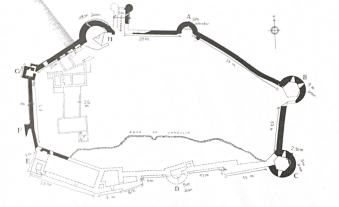

Analysing the Castle and its rooms
| Barbican
A barbican is a fortified outpost or gateway, such as an outer defense to a city or castle, or any tower situated over a gate or bridge which was used for defensive purposes. Usually barbicans were situated outside the main line of defences and connected to the city walls with a walled road called the neck. Fortified or mock-fortified gatehouses remained a feature of ambitious French and English residences into the 17th century. |
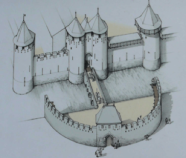 |
| Stables
A stable is a building in which livestock, especially horses, are kept. It most commonly means a building that is divided into separate stalls for individual animals. |
 |
| Bailey
In fortifications, a bailey or ward refers to a courtyard enclosed by a curtain wall. In particular, an early type of European castle was known as a Motte-and-bailey. |
 |
| Solar
The solar was a room in many English and French medieval manor houses, great houses and castles, designed as the family’s private living and sleeping quarters. Within castles they are often called the ‘Lords’ and ‘Ladies Chamber’, or the ‘Great Chamber’. The word ‘Solar’ derives from the Latin word ‘solaris’ meaning sun, and the Solar room was situated within the building, in a room with the brightest aspect. |
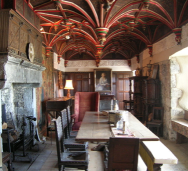 |
| Postern Gate
A postern is a secondary door or gate in a fortification. Posterns were often located in a concealed location which allowed the occupants to come and go inconspicuously. In the event of a siege, a postern could act as a sally port. |
 |
Textures

Deadlines
This project’s deadline is the 30th of march 2018.
Team Roles and Bio:
-Giacomo Verri: Leader & 3D Modeller
-Jack Hallett: Researcher & Artist
-James Lewis: Programmer & Texture Prep
-Jon How: Voiceover & Producer
Time Scales:
We have divided this project in smaller tasks to easily plan ahead what we would need to prioritise.
–Graphics and Drawings finished by the 23/02/2018 (2 Concept Drawings, Interactive Signs, Seamless Textures)
–Castle Model (Primary) finished in a 20 day span, including landscape.
–Decor Models (Secondary and Tertiary) started after the main castle was finished, and aimed to be completed in one week – by 20/03/2018
-With 10 days left we aim to record the Script and implement it into the level, as well as interactive objects like the drawbridge and opening doors.
-By the 27th we aim to have have finished everything, having just Visual Dress-Up left before recording the flythrough video.
Resources
The resources we will need to make this is going to include software to develop the interactive experience and model and design assets for it, and lots of various concepts using both paper and photos taken on site.
We decided to use Unreal Engine and Maya/Cinema4D to develop and model the experience because they are easy to learn and intuitive. We also decided to use Illustrator to design vector graphics (as they can be freely rescaled) and Photoshop for texture preparation. We chose these programs because we have previous experience in using them, thus making it the best choice, as they are effortlessly accessible and easy to use.
There will be some obstacles that we will have to conquer through as a team. One of the main obstacles will be the coding, as we don’t a lot of experience with it since we are still beginners learning as we go. Another obstacle that we will face is our graphics creation because we are not proficient with creating new original images without needing lots of time which isn’t an option as we are entering an industry where deadlines are strict.
Demographics
The demographic for the castle demo will be mainly people interested in the history of Hadleigh Castle. This will be both male and females of diverse backgrounds and education levels aged 14 and up. This means the experience will need to be interactive and easy to use.
Production Log
Here is our production log.
YouTube Flythrough
Here is a link to the YouTube flythrough
Tour Download
Here is a link to download the interactive tour
Evaluation
Overall the project turned out good. We had a few problems here and there, but we managed to overcome them.
When exporting the models into .fbx format, the tower model kept exporting with holes in it, we managed to fix it by inverting the normal on a few faces of the model.
As expected, coding was not easy, but we teamed up in a group and solved the main issues we had with opening doors, ladders and audio implementation.
Lastly, a teammate left us, so we had to quickly prioritise each role and focus on more tasks at once, which was hard, but we got through it in the end. We were not able to finish the YouTube flythrough in time for the deadline, so we had to take an extra week to finish it.
Overall, if we had a little more time we could have improved all of the models and texturing jobs all round, as well as having everything perfected and bug free regarding programming.